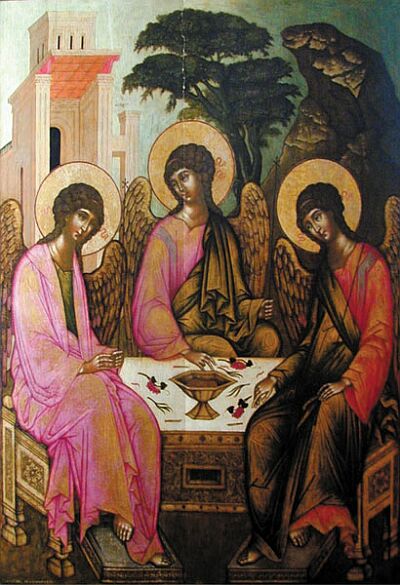One of the main things that has interested me throughout the years is the art and symbols left by religions. Anyway, I listened to the talk about the
deathless and thought I would post about the trinities and see what others thought. To my understanding they represent mainly a day in the contemplative life among other things.
Holy TrimurtiBrahma = creation, life, waking state, conscious, rules from dawn til dusk
Shiva = destruction, death, sleep state, unconscious, rules from dusk til dawn
Vishnu = maintainer, holy spirit, samadhi/jhana, altered states of consciousness
Trimurti/Avatar = a being who has achieved
eternal life/deathless/buddhahood/moksha/nibbana/unbroken consciousness
The above picture best represents the Holy Trimurti. They read:
Left = Brahma - Being of light skin symbolizing the day.
Middle = Vishnu - The holy spirit - Note the 7 snakes (8 stages of samadhi) and the body of a snake rising from the ground up the body.
Right = Shiva - Being of darker skin than both Brahma and Vishnu therefore symbolizing night - sometimes pictured with a moon.

The above picture is of Dattatreya, an avatar of the Trimurti. Note the three heads but one body.
The Holy TrinityFather = represents creation of life, waking state, conscious.
Son = Is written in Greek as υἱός and has an alternative translation meaning a term describing man, carrying the connotation of weakness and mortality – therefore represents death, night, sleep state, unconscious
Holy spirit = represents the transformation of the soul to eternal life, the 8 stages of samadhi/jhana, altered states of consciousness
God = the sum total of the spiritual dimension, which pervades the physical universe, but does not direct, control or create, or modify or destroy it. - This is a quote from Jhanananda.
Jesus the name of a man's body.
Christ = a being who has achieved
eternal life/deathless/buddhahood/moksha/nibbana/unbroken consciousnessson translation source:
http://www.laparola.net/greco/parola.php?p=%CF%85%E1%BC%B1%E1%BD%B9%CF%82
The above picture is probably the best representation of the Holy Trinity I have come across in Christian art. Note that they are all the same person, however their clothes and backgrounds respective to them are different. They read:
Left = Holy spirit - The background building symbolizing the spiritual dimension - Note:The biblical reference of church is not a physical church on the material plane. Clothes are lightly colored - symbolic of purity
Middle = Father - The background tree symbolizing life and creation.
Right = Son - The background rock symbolizing lifeless/death. The person is dressed in dark colors.

The above picture shows Jesus as having three heads but one body and a picture of Holy Trinity.
There are other 'deities' throughout history where this trinity can be applied to -
https://en.wikipedia.org/wiki/Triple_deity

